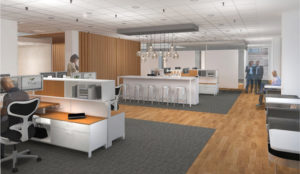Interior Design to Create a Great Corporate Office
October 9, 2017
Impress clients, inspire employees and create all-around functionality
 Everyone prefers to arrive at work with energy and motivation, but sometimes the thought of spending the entire day trapped in an un-inspiring building or cramped cubicle injects dread into the matutinal commute and poison into corporate culture.
Everyone prefers to arrive at work with energy and motivation, but sometimes the thought of spending the entire day trapped in an un-inspiring building or cramped cubicle injects dread into the matutinal commute and poison into corporate culture.
In an age when attracting retaining top talent is at an all-time premium, excellence in office design should also be held in high priority. A recent Forbes survey found that 73% of respondents said that their work area and office facilities directly influenced their job satisfaction. While hiring experienced employees with great attitudes remains fundamental for building a successful company, many managers cite the need to facilitate and motivate the workforce by having systems in place to enable the employees’ success. This includes intentionally designing offices to facilitate workflow, collaboration, productivity, and ultimately employee happiness. Despite the acknowledged value for office design, many companies fail to adequately evaluate, and periodically re-evaluate, their companies changing product mix, workflow, and workforce preferences. Below is a list of considerations to maximize your workplace to achieve the three goals of a great office: impress clients, inspire employees and create all-around functionality.
- Space Planning. It is crucial to take a look at the entranceway, common areas (restrooms, kitchen, break rooms, etc.), and meeting space to determine their optimum use. Consider what works, what does not, and review management’s wish list. How can the layouts be truncated or expanded for greater efficiency. For employee workspace, evaluate the roles of the employees and determine how much space they need. Consider things like electric and IT infrastructure, furniture, storage and workspace. Examine the layout and locations of departments and work groups and re-position the spaces accordingly.
- Interior Architecture. Analyze the industry, company’s culture, brand and how clients and customers should feel when they walk in. With this in mind design to wow and achieve those feelings with fabrics, furniture, colors, textures, and other accessories.
- In today’s world keeping employees happy and productive is imperative. Examine the company’s brand, work philosophy, strategic goals, communications, employee interactions, and management styles. The interior design should support and facilitate these qualities to make their jobs easier (greater efficiency) and at a minimum more fun.
- Client participation. A good interior designer is a great listener and asks many questions about all facets of the client’s business and work habits. If clients do not have a clear vision for their office layout and interior architecture then the designer will be ready for meaningful recommendations. The creation or remodeling of an office space relies heavily on client input. It’s the designer’s job to navigate them through the process.
DesignPoint is a full-service interior design firm that has helped thousands of corporate offices and doctor’s offices perform to their maximum potential for client engagement and employee productivity. Over the next few months, DesignPoint will be highlighting a few client stories that will provide insight into how top executives work. The stories exemplify how to strategically inject best practices for space planning, layouts, and interior design for successful businesses.
If you are interested in learning about DesignPoint’s interior design services call them at 610-807-9670 or visit https://designpoint-interiors.com/.